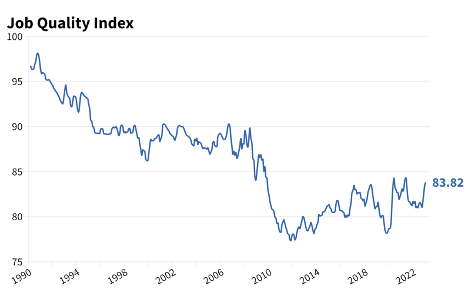WASHINGTON — The Coalition for a Prosperous America (CPA) today announced that the U.S. Private Sector Job Quality Index (JQI) edged up by 0.17% in February to 83.82, reflecting slightly faster growth in high-quality jobs than low-quality in the month.
Contributing to the rise in the index was an increase of 61,500 jobs in health care and social assistance and 12,000 jobs created in wholesale trade. While health care and social assistance has more low-quality than high-quality jobs overall, the sector created 22,590 high-quality jobs in February. Wholesale trade is predominantly high-quality jobs as the average weekly wage is $1135, above the average weekly wage for production and nonsupervisory employees.
The average weekly wage for production and nonsupervisory workers in February was $966.75. Wage growth was nearly flat, up only 0.13% from the previous month. Over the past year, the average weekly wage has increased $42, up 4.5%. In real terms, production and nonsupervisory workers are losing purchasing power as their wage growth is below the rate of inflation of consumer prices over the past year of 6.0%. Workers in low-quality jobs have fared worse as their average weekly wage declined in February by 0.3% and have increased by only 3.3% over the past year.
While the Bureau of Labor Statistics reported overall job gains of 236,000 in March and a slightly lower unemployment rate of 3.5%, some sectors with high-quality jobs contracted employment over the past month. The construction industry lost 9,000 jobs and manufacturing lost 1,000 jobs. Meanwhile, more than half of the jobs created were in sectors with low-quality jobs such as leisure and hospitality gained 72,000 and healthcare gained 50,000. The JQI Instant shows that 73% of the gain in March was of low-quality jobs that pay below the average weekly income. Job growth has steadily slowed over recent months, and sectors that create high-paying jobs are now showing a contraction in employment.
The Job Quality Index measures job quality for U.S. production and non-supervisory workers by comparing workers’ weekly wages to the mean weekly wage for all non-supervisory workers. Those jobs above the mean are classified as high-quality and those below the mean are low-quality. The index is calculated by dividing the number of high-quality jobs by low-quality jobs. An index of 100 means the number of high-quality production and nonsupervisory jobs is equal to the number of low-quality jobs. An index below 100 means that the economy includes more low-quality than high-quality jobs.
Over the past three decades, the JQI declined because the U.S. economy created more low-quality jobs than it has high-quality jobs. As shown in Figure 1, the JQI is down 12.8% from 1990 illustrating the disproportionate growth in low-wage, low-hour jobs.
Figure 1. Job Quality Index 1990-2023













